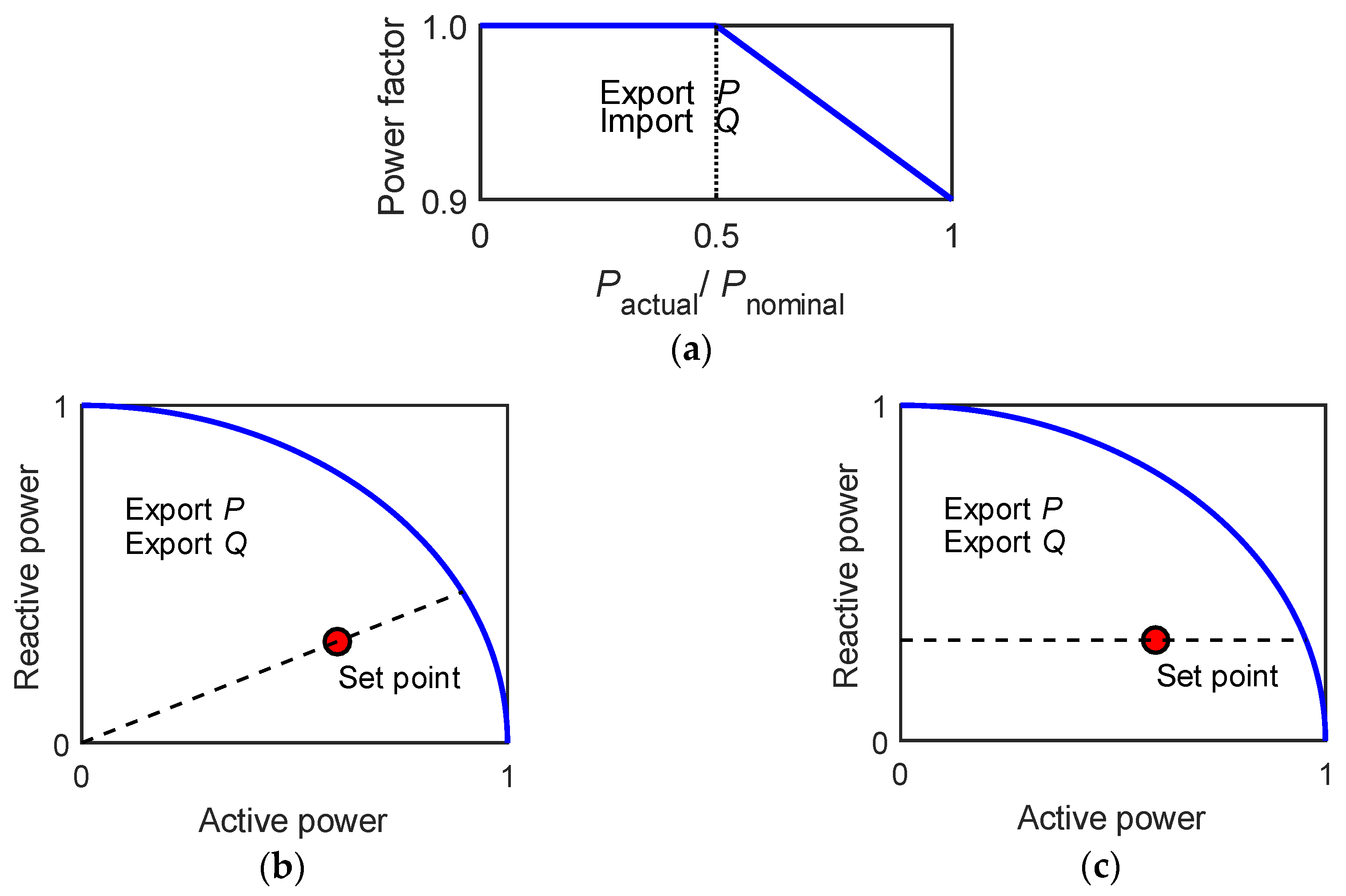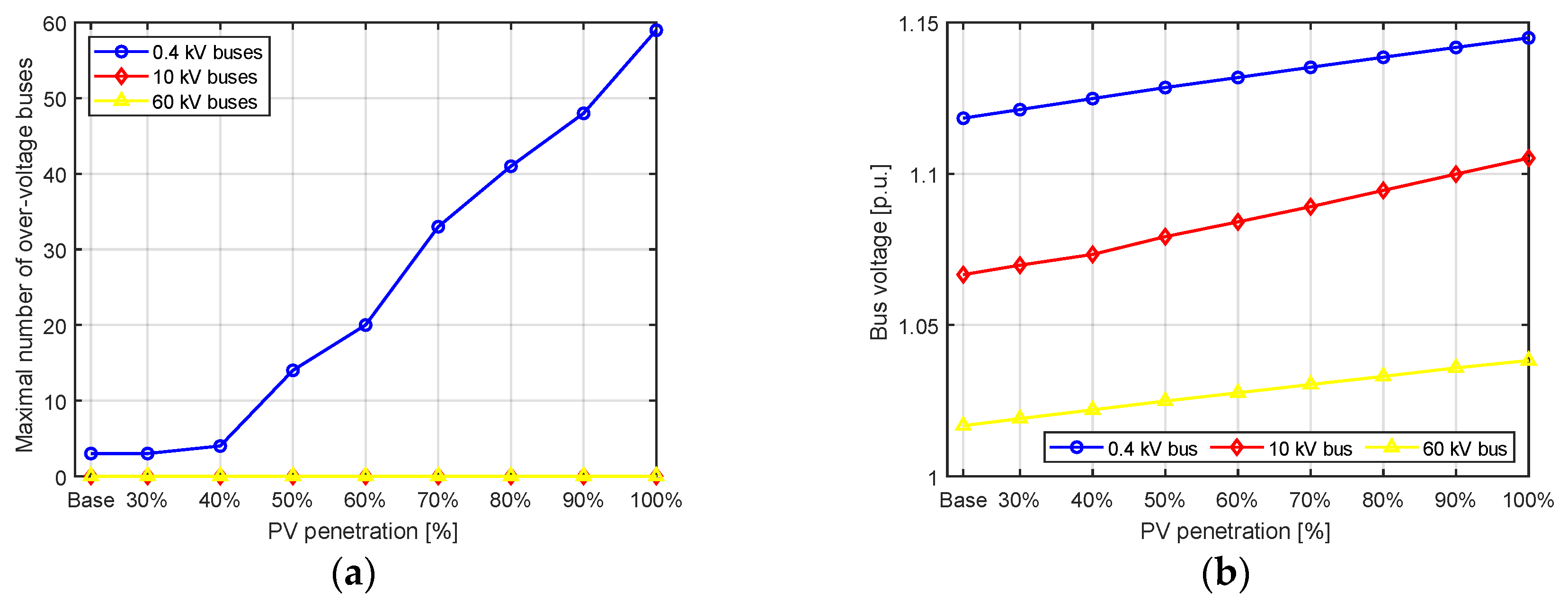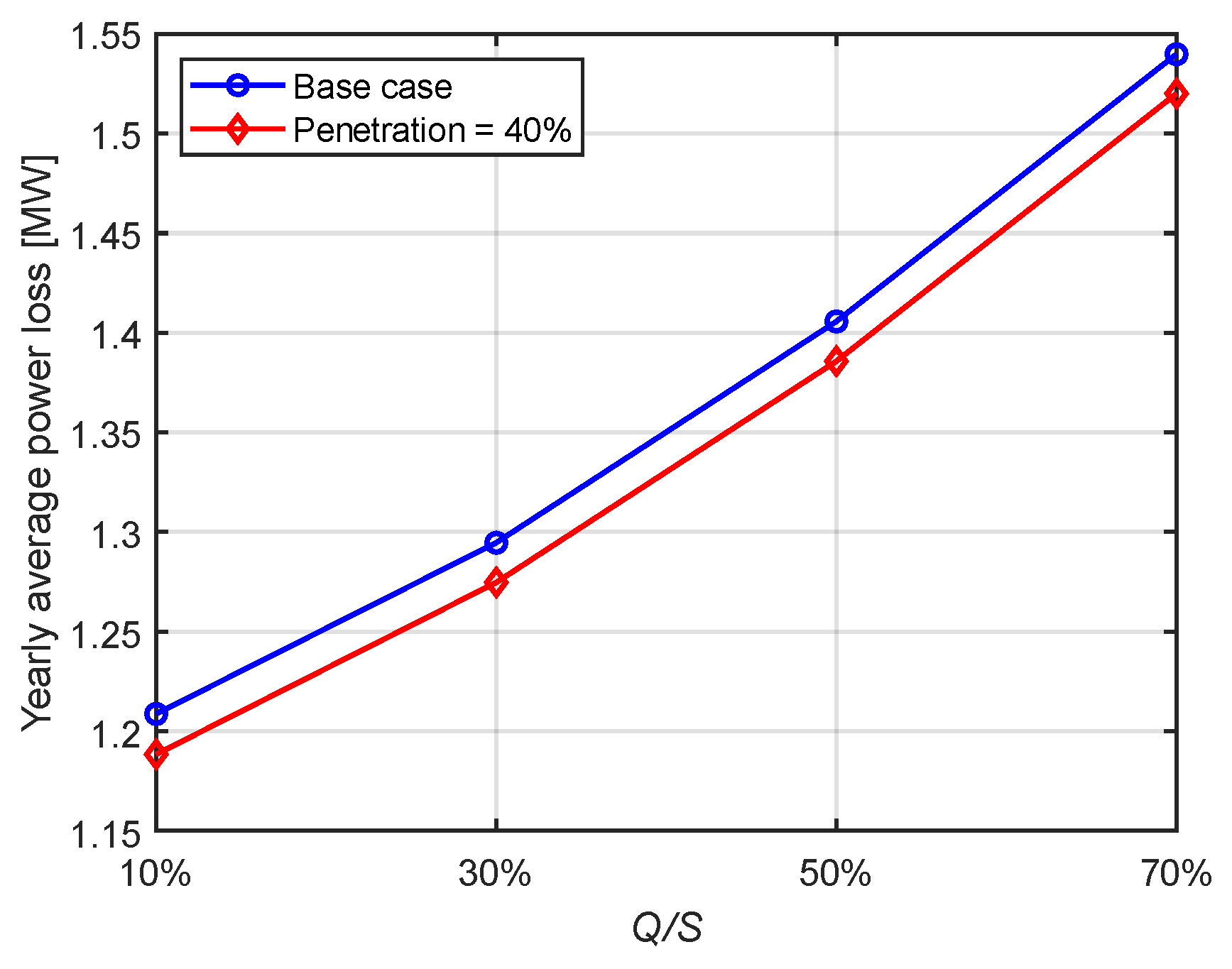Static Operational Impacts of Residential Solar PV Plants on the Medium Voltage Distribution Grids—A Case Study Based on the Danish Island Bornholm
Abstract
:1. Introduction
1.1. Background
1.2. State-of-the-Art
1.3. The Scope of the Case Study
2. Methods
2.1. The Bornholm Power System
2.2. Assessment of the Reactive Power Provision
- Lagging PF: equivalent to the over-excited synchronous generator, inverter exports both P and Q, operation in the first quadrant;
- Leading PF: equivalent to the under-excited synchronous generator, inverter exports P and imports Q, operation in the fourth quadrant.
2.3. Load and PV Generation Profile Modeling
3. Results and Discussion
3.1. PF(P) Control
3.2. Constant PF Control
3.3. Constant Q Control
3.4. Summary of Case Studies
4. Conclusions
Author Contributions
Funding
Conflicts of Interest
References
- The Danish Ministry of Climate, Energy and Building. Energy Strategy 2050—From Coal, Oil and Gas to Green Energy; The Danish Ministry of Climate, Energy and Building: Copenhagen, Denmark, 2011. [Google Scholar]
- International Energy Agency (IEA). Energy Policies of IEA Countries: Denmark—2017 Review; International Energy Agency (IEA): Fribourg, Switzerland, 2017. [Google Scholar]
- International Energy Agency (IEA). Photovoltaic Power System Program PVPS Annual Report 2017; International Energy Agency (IEA): Fribourg, Switzerland, 2018. [Google Scholar]
- Alet, P.-J.; Baccaro, F.; De Felice, M.; Efthymiou, V.; Mayr, C.; Graditi, G.; Juel, M.; Moser, D.; Petitta, M.; Tselepis, S.; et al. Quantification, challenges and outlook of PV integration in the power system: A review by the European PV Technology Platform. In Proceedings of the 31st European Photovoltaic Solar Energy Conference and Exhibition (EU PVSEC 2015), Hamburg, Germany, 14–18 September 2015. [Google Scholar]
- Alet, P.-J.; Baccaro, F.; De Felice, M.; Efthymiou, V.; Mayr, C.; Graditi, G.; Juel, M.; Moser, D.; Petitta, M.; Tselepis, S.; et al. Photovoltaics Merging with the Active Integrated Grid: Grid Integration White Paper of the EU PV Technology Platform, Working Group on Grid Integration; European Technology and Innovation Platform Photovoltaics: Neuchâtel, Switzerland, 2015. [Google Scholar]
- Singh, S.N.; Østergaard, J.; Jain, N. Distributed Generation in Power Systems: An Overview and Key Issues. In Proceedings of the 24th Indian Engineering Congress, Kerale, India, 10–13 December 2009. [Google Scholar]
- Adefarati, T.; Bansal, R.C. Integration of renewable distributed generators into the distribution system: A review. IET Renew. Power Gener. 2016, 10, 873–884. [Google Scholar] [CrossRef]
- Zsiborács, H.; Vincze, A.; Csányi, S.; Vincze, A.; Pintér, C. Economic Analysis of Grid-Connected PV System Regulations: A Hungarian Case Study. Electronics 2019, 8, 149. [Google Scholar] [CrossRef]
- Yang, G.; Hou, P.; Sera, D.; Martins, J.P.R.; Douglass, P.J.; Martens, S.; Johansen, P.M.; Svendsen, D.K.; Moth, K. Integration of PV+Storage—Technical and Economic Evaluation at Distribution Grids. In Proceedings of the 8th Integration Workshop on the Integration of Solar Power into Power Syatems, Stockholm, Sweden, 15–16 October 2018. [Google Scholar]
- Dierckxsens, C.; Woyte, A.; Bletterie, B.; Zegers, A.; Deprez, W.; Dexters, A.; Van Roey, K.; Lemmens, J.; Lowette, J.; Nulens, K.; et al. Cost-Effective Integration of Photovoltaics in Existing Distribution Grids: Results and Recommendations; MetaPV: Brussels, Belgium, 2015. [Google Scholar]
- Project PV Island Bornholm (PVIB). Available online: https://ses.jrc.ec.europa.eu/pv-island-bornholm (accessed on 22 January 2019).
- Mateo, C.; Frías, P.; Cossent, R.; Sonvilla, P.; Barth, B. Overcoming the barriers that hamper a large-scale integration of solar photovoltaic power generation in European distribution grids. Sol. Energy 2017, 153, 574–583. [Google Scholar] [CrossRef]
- Katiraei, F.; Agüero, J.R. Solar PV Integration Challenges. IEEE Power Energy Mag. 2011, 9, 62–71. [Google Scholar] [CrossRef]
- Hashemi, S.; Østergaard, J. Methods and strategies for overvoltage prevention in low voltage distribution systems with PV. IET Renew. Power Gener. 2017, 11, 205–214. [Google Scholar] [CrossRef] [Green Version]
- Comello, S.; Reichelstein, S.; Sahoo, A. The road ahead for solar PV power. Renew. Sustain. Energy Rev. 2018, 92, 744–756. [Google Scholar] [CrossRef]
- Yang, G.; Kjær, S.B.; Frederiksen, K.H.B.; Ipsen, H.H.; Refshauge, R.H. PVNET Final Report—PV Integration Studies; DTU Library: Kgs. Lyngby, Denmark, 2016. [Google Scholar]
- Kjær, S.B.; Lazar, R.D.; Constantin, A.; Ballegaard, H.P.; Yang, G.; Østergaard, J.; Ipsen, H.H.; Frederiksen, K.H.B. Voltage control in low voltage networks by Photovoltaic Inverters—PVNET.dk. In Proceedings of the 28th European Photovoltaic Solar Energy Conference and Exhibition (EU PVSEC 2013), Villepinte, France, 30 September–4 October 2013. [Google Scholar] [CrossRef]
- Steen, D.; Goop, J.; Göransson, L.; Nursbo, S. Challenges of Integrating Solar and Wind into the Electricity Grid. In Systems Perspectives on Renewable Power; Sandén, B., Ed.; Chalmers University of Technology: Göteborg, Sweden, 2015; Chapter 9; pp. 9–107. ISBN 9789198097405. [Google Scholar]
- CIGRE. CIGRE Working Group C6.24: Capacity of Distribution Feeders for Hosting DER; CIGRE: Paris, France, 2014. [Google Scholar]
- Kraiczy, M.; Fakhri, L.A.; Stetz, T.; Braun, M. Do It Locally: Local Voltage Support by Distributed Generation—A Management Summary: Management Summary of IEA Task 14 Subtask 2—Recommendations Based on Research and Field Experience; IEA Internation Energy Agency: Fribourg, Switzerland, 2017. [Google Scholar]
- Collins, L.; Ward, J.K. Real and reactive power control of distributed PV inverters for overvoltage prevention and increased renewable generation hosting capacity. Renew. Energy 2015, 81, 464–471. [Google Scholar] [CrossRef]
- Tonkoski, R.; Lopes, L.A.C.; El-Fouly, T.H.M. Coordinated Active Power Curtailment of Grid Connected PV Inverters for Overvoltage Prevention. IEEE Trans. Sustain. Energy 2011, 2, 139–147. [Google Scholar] [CrossRef]
- Juamperez, M.; Yang, G.; Kjær, S.B. Voltage regulation in LV grids by coordinated volt-var control strategies. J. Mod. Power Syst. Clean Energy 2014, 2, 319–328. [Google Scholar] [CrossRef] [Green Version]
- Molina-garcía, Á.; Mastromauro, R.A.; García-Sánchez, T.; Pugliese, S.; Liserre, M.; Stasi, S. Reactive Power Flow Control for PV Inverters Voltage Support in LV Distribution Networks. IEEE Trans. Smart Grid 2017, 8, 447–456. [Google Scholar] [CrossRef]
- Liu, X.; Cramer, A.M.; Liao, Y. Reactive power control methods for photovoltaic inverters to mitigate short-term voltage magnitude fluctuations. Electr. Power Syst. Res. 2015, 127, 213–220. [Google Scholar] [CrossRef]
- Yang, G.; Marra, F.; Juamperez, M.; JÆR, S.B.K.; Hashemi, S.; Østergaard, J.; Ipsen, H.H.; Frederiksen, K.H.B. Voltage rise mitigation for solar PV integration at LV grids: Studies from PVNET.dk. J. Mod. Power Syst. Clean Energy 2015, 3, 411–421. [Google Scholar] [CrossRef]
- Hashemi Toghroljerdi, S.; Østergaard, J.; Yang, G. Effect of reactive power management of PV inverters on need for energy storage. In Proceedings of the 39th IEEE Photovoltaic Specialists Conference, Tampa, FL, USA, 18–21 June 2013. [Google Scholar] [CrossRef]
- Karimi, M.; Mokhlis, H.; Naidu, K.; Uddin, S.; Bakar, A.H.A. Photovoltaic penetration issues and impacts in distribution network—A review. Renew. Sustain. Energy Rev. 2016, 53, 594–605. [Google Scholar] [CrossRef]
- Abdelmotteleb, I.; Gómez, T.; Chaves-Avila, J.P. Benefits of PV Inverter Volt-Var Control on Distribution Network Operation. In Proceedings of the 12th IEEE Power and Energy Society PowerTech Conference, Manchester, UK, 18–22 June 2017. [Google Scholar] [CrossRef]
- Wang, L.; Yan, R.; Saha, T.K. Voltage Management for Large Scale PV Integration into Weak Distribution Systems. IEEE Trans. Smart Grid 2018, 9, 4128–4139. [Google Scholar] [CrossRef]
- Alatrash, H.; Amarin, R.A.; Lam, C. Enabling large-scale PV integration into the grid. In Proceedings of the 2012 IEEE Green Technologies Conference, Tulsa, OK, USA, 19–20 April 2012. [Google Scholar] [CrossRef]
- Fuchs, A.; Demiray, T. Large-scale PV integration strategies in distribution grids. In Proceedings of the 2015 IEEE Eindhoven PowerTech, Eindhoven, Netherlands, 29 June–2 July 2015. [Google Scholar] [CrossRef]
- Ranaweera, I.; Midtgård, O.M.; Korpås, M. Distributed control scheme for residential battery energy storage units coupled with PV systems. Renew. Energy 2017, 113, 1099–1110. [Google Scholar] [CrossRef] [Green Version]
- Energinet. Technical Regulation 3.2.1 for Power Plants up to and Including 11 kW; Energinet: Fredericia, Denmark, 2016. [Google Scholar]
- Energinet. Technical Regulation 3.2.2 for PV Power Plants Above 11 kW; Energinet: Fredericia, Denmark, 2016. [Google Scholar]
- Tant, J.; Geth, F.; Six, D.; Tant, P.; Driesen, J. Multiobjective Battery Storage to Improve PV Integration in Residential Distribution Grids. IEEE Trans. Sustain. Energy 2013, 4, 182–191. [Google Scholar] [CrossRef] [Green Version]
- Schopfer, S.; Tiefenbeck, V.; Staake, T. Economic assessment of photovoltaic battery systems based on household load profiles. Appl. Energy 2018, 223, 229–248. [Google Scholar] [CrossRef]
- Zsiborács, H.; Baranyai, N.H.; Vincze, A.; Haber, I.; Pintér, G. Economic and Technical Aspects of Flexible Storage Photovoltaic Systems in Europe. Energies 2018, 11, 1445. [Google Scholar] [CrossRef]
- Karimi, Y.; Oraee, H.; Guerrero, J.M.; Vasquez, J.C.; Savaghebi, M. Method for Load Sharing and Power Management in a Hybrid PV/Battery Source Islanded Microgrid. In Proceedings of the IEEE 7th Power Electronics and Drive Systems Technologies Conference (PEDSTC), Tehran, Iran, 16–18 February 2016. [Google Scholar] [CrossRef]
- PV + Storage—Operation and Economics. Available online: https://energiforskning.dk/en/node/9129 (accessed on 6 April 2019).
- Marra, F.; Yang, G.; Fawzy, Y.T.; Træholt, C.; Larsen, E.; Garcia-Valle, R.; Jensen, M.M. Improvement of Local Voltage in Feeders With Photovoltaic Using Electric Vehicles. IEEE Trans. Power Syst. 2013, 28, 3515–3516. [Google Scholar] [CrossRef]
- Hannan, M.A.; Hoque, M.M.; Mohamed, A.; Ayob, A. Review of energy storage systems for electric vehicle applications: Issues and challenges. Renew. Sustain. Energy Rev. 2017, 69, 771–789. [Google Scholar] [CrossRef]
- Balamurugan, K.; Srinivasan, D.; Reindl, T. Impact of distributed generation on power distribution systems. Energy Procedia 2012, 25, 93–100. [Google Scholar] [CrossRef]
- Bayer, B.; Matschoss, P.; Thomas, H.; Marian, A. The German experience with integrating photovoltaic systems into the low-voltage grids. Renew. Energy 2018, 119, 129–141. [Google Scholar] [CrossRef] [Green Version]
- Chattopadhyay, R.; Bhattacharya, S.; Foureaux, N.C.; Pires, I.A.; de Paula, H.; Moraes, L.; Cortizio, P.C.; Silva, S.M.; Filho, B.C.; de S. Brito, J.A. Low voltage PV power integration into medium voltage grid using high voltage SiC devices. In Proceedings of the 2014 International Power Electronics Conference (IPEC-Hiroshima 2014—ECCE ASIA), Hiroshima, Japan, 18–21 May 2014. [Google Scholar] [CrossRef]
- Hanser, P.; Lueken, R.; Gorman, W.; Masha, J.; Group, T.B. The practicality of distributed PV-battery systems to reduce household grid reliance. Util. Policy 2017, 46, 22–32. [Google Scholar] [CrossRef]
- Schwaegerl, C.; Bollen, M.H.J.; Karoui, K.; Yagmur, A. Voltage control in distribution systems as a limitation of the hosting capacity for distributed energy resources. In Proceedings of the 18th International Conference and Exhibition on Electricity Distribution, Turin, Italy, 6–9 June 2005. [Google Scholar] [CrossRef]
- Sarabia, A.F. Impact of Distributed Generation on Distribution System. Master’s Thesis, Aalborg University, Aalborg, Denmark, 2011. [Google Scholar]
- Mustafa, G. Control and Protection in Low Voltage Grid with Large Scale Renewable Electricity Generation. Ph.D. Thesis, Aalborg University, Aalborg, Denmark, 2014. [Google Scholar]
- Østergaard, J.; Nielsen, J.E. The Bornholm Power System—An Overview; DTU Library: Kgs. Lyngby, Denmark, 2010. [Google Scholar]
- Yang, G.; Oleson, O.J. Secure Operation of Sustainable Power System (SOSPO) WP1: Future Scenario Description, System in Dontext and Specifications; DTU Library: Kgs. Lyngby, Denmark, 2013. [Google Scholar]
- Area of Danish Municipalities. Available online: https://www.dst.dk/en/Statistik/emner/geografi-miljoe-og-energi/areal/areal (accessed on 6 April 2019).
- Andresen, G.B.; Rodriguez, R.A.; Becker, S.; Greiner, M. The potential for arbitrage of wind and solar surplus power in Denmark. Energy 2014, 76, 49–58. [Google Scholar] [CrossRef]
- CIGRE. CIGRE Task Force C6.04: Benchmark Systems for Network Integration of Renewable and Distributed Energy Resources; CIGRE: Paris, France, 2014. [Google Scholar]
- Dupré, O.; Vaillon, R.; Green, M.A. Temperature Coefficients of Photovoltaic Devices. In Thermal Behavior of Photovoltaic Devices: Physics and Engineering; Springer International Publishing AG: Cham, Switzerland, 2017; Chapter 2; pp. 29–74. ISBN 9783319494562. [Google Scholar]












| Parameters | Entire Denmark | Bornholm |
|---|---|---|
| Population (thousand) | 5806 | 39.715 |
| Area (km2) | Approx. 42,934.10 | Approx. 588.40 |
| Peak load (MW) | Approx. 6000 | 55 |
| Annual energy consumption (GWh) | Approx. 36,000 | Approx. 262 |
| Number of transformer stations | Approx. 70,000 | Approx. 1000 |
| Control Methods | Power Loss of the Entire Grid (MW) | Max. Number of Overvoltage Buses | Max. Number of Overload Transformers | Max. Bus Voltage (p.u.) | Max. Transformer Loading Rate (%) |
|---|---|---|---|---|---|
| PF(P) | 1.17 | 3 | 6 | 1.118 | 218.99 |
| Constant PF | 1.16 | 309 | 6 | 1.115 | 218.9 |
| Constant Q | 1.21 to1.54 | 4 to82 | 4 to 5 | 1.157 | 219.76 |
| Control Methods | Power Loss of the Entire Grid (MW) | Max. Number of Overvoltage Buses | Max. Number of Overload Transformers | Max. Bus Voltage (p.u.) | Max. Transformer Loading Rate (%) |
|---|---|---|---|---|---|
| PF(P) | 1.15 | 6 | 6 | 1.125 | 218.96 |
| Constant PF | 1.13 | 68 | 7 | 1.115 | 218.9 |
| Constant Q | 1.19 to 1.52 | 31 to 107 | 4 to 5 | 1.166 | 219.76 |
© 2019 by the authors. Licensee MDPI, Basel, Switzerland. This article is an open access article distributed under the terms and conditions of the Creative Commons Attribution (CC BY) license (http://creativecommons.org/licenses/by/4.0/).
Share and Cite
Wang, Z.; Yang, G. Static Operational Impacts of Residential Solar PV Plants on the Medium Voltage Distribution Grids—A Case Study Based on the Danish Island Bornholm. Energies 2019, 12, 1458. https://doi.org/10.3390/en12081458
Wang Z, Yang G. Static Operational Impacts of Residential Solar PV Plants on the Medium Voltage Distribution Grids—A Case Study Based on the Danish Island Bornholm. Energies. 2019; 12(8):1458. https://doi.org/10.3390/en12081458
Chicago/Turabian StyleWang, Ziyu, and Guangya Yang. 2019. "Static Operational Impacts of Residential Solar PV Plants on the Medium Voltage Distribution Grids—A Case Study Based on the Danish Island Bornholm" Energies 12, no. 8: 1458. https://doi.org/10.3390/en12081458





